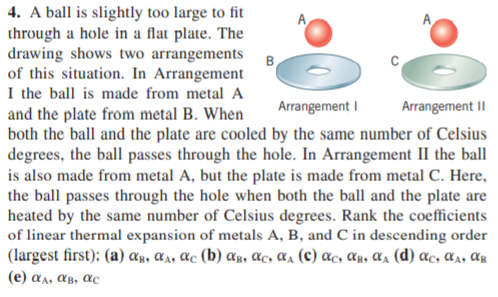4. A ball is slightly too large to fit through a hole in a flat plate. The drawing shows two arrangements of this situation. In Arrangement I the ball is made from metal A and the plate from metal B. When both the ball and the plate are cooled by the same number of Celsius degrees, the ball passes through the hole. In Arrangement II the ball is also made from metal A, but the plate is made from metal C. Here, the ball passes through the hole when both the ball and the plate are heated by the same number of Celsius degrees. Rank the coefficients of linear thermal expansion of metals A, B, and C in descending order (largest first): (a) æg, &a, &c (b) ag, ac, as (c) ac, ag, a^ (d) ac, ax, ɑg Arrangement I Arrangement II (e) aa, aB, ac
4. A ball is slightly too large to fit through a hole in a flat plate. The drawing shows two arrangements of this situation. In Arrangement I the ball is made from metal A and the plate from metal B. When both the ball and the plate are cooled by the same number of Celsius degrees, the ball passes through the hole. In Arrangement II the ball is also made from metal A, but the plate is made from metal C. Here, the ball passes through the hole when both the ball and the plate are heated by the same number of Celsius degrees. Rank the coefficients of linear thermal expansion of metals A, B, and C in descending order (largest first): (a) æg, &a, &c (b) ag, ac, as (c) ac, ag, a^ (d) ac, ax, ɑg Arrangement I Arrangement II (e) aa, aB, ac
College Physics
1st Edition
ISBN:9781938168000
Author:Paul Peter Urone, Roger Hinrichs
Publisher:Paul Peter Urone, Roger Hinrichs
Chapter13: Temperature, Kinetic Theory, And The Gas Laws
Section: Chapter Questions
Problem 18PE: Most automobiles have a coolant reservoir to catch radiator fluid than may overflow when 1he engine...
Related questions
Question

Transcribed Image Text:4. A ball is slightly too large to fit
through a hole in a flat plate. The
drawing shows two arrangements
of this situation. In Arrangement
I the ball is made from metal A
and the plate from metal B. When
both the ball and the plate are cooled by the same number of Celsius
degrees, the ball passes through the hole. In Arrangement II the ball
is also made from metal A, but the plate is made from metal C. Here,
the ball passes through the hole when both the ball and the plate are
heated by the same number of Celsius degrees. Rank the coefficients
of linear thermal expansion of metals A, B, and C in descending order
(largest first): (a) æg, &a, &c (b) ag, ac, as (c) ac, ag, a^ (d) ac, ax, ɑg
Arrangement I
Arrangement II
(e) aa, aB, ac
Expert Solution
This question has been solved!
Explore an expertly crafted, step-by-step solution for a thorough understanding of key concepts.
This is a popular solution!
Trending now
This is a popular solution!
Step by step
Solved in 2 steps with 2 images

Recommended textbooks for you

College Physics
Physics
ISBN:
9781938168000
Author:
Paul Peter Urone, Roger Hinrichs
Publisher:
OpenStax College

College Physics
Physics
ISBN:
9781305952300
Author:
Raymond A. Serway, Chris Vuille
Publisher:
Cengage Learning

Physics for Scientists and Engineers, Technology …
Physics
ISBN:
9781305116399
Author:
Raymond A. Serway, John W. Jewett
Publisher:
Cengage Learning

College Physics
Physics
ISBN:
9781938168000
Author:
Paul Peter Urone, Roger Hinrichs
Publisher:
OpenStax College

College Physics
Physics
ISBN:
9781305952300
Author:
Raymond A. Serway, Chris Vuille
Publisher:
Cengage Learning

Physics for Scientists and Engineers, Technology …
Physics
ISBN:
9781305116399
Author:
Raymond A. Serway, John W. Jewett
Publisher:
Cengage Learning

College Physics
Physics
ISBN:
9781285737027
Author:
Raymond A. Serway, Chris Vuille
Publisher:
Cengage Learning

Principles of Physics: A Calculus-Based Text
Physics
ISBN:
9781133104261
Author:
Raymond A. Serway, John W. Jewett
Publisher:
Cengage Learning
